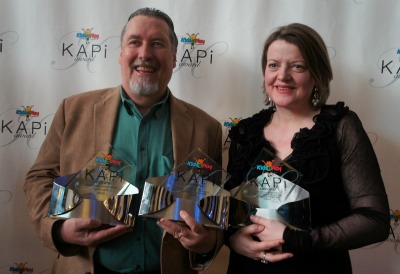Tucked upstairs in a small room, just above the scrum of the show floor at CES, the annual Consumer Electronics Show in Las Vegas, digital publishers and app developers gathered to talk shop, specifically what makes a great ebook experience for kids.
See also LJ‘s coverage of CES:
CES 2012: The Shapes of Things to Come
“One of the mantras at Barnes & Noble is that books aren’t broken,” says Wendy Bronfin, the company’s senior director of children’s digital products, speaking at the Kids@Play Summit held January 12 at CES. “We’re carefully translating stories to a new platform.”
What makes a good digital story is an ongoing experiment by all content developers, whose efforts range from straight text to interactive narratives. Is it an ebook? An app? For publishers, the semantics are less important than whether the content is engaging—librarians and teachers would likely agree, as many are forging their own path in developing digital libraries to serve kids.
“That’s why I’m here,” says James Staub, the systems and emerging tech librarian for the Nashville (TN) Public Library, who attended the session. “We’re very committed to expanding our digital content.”

Mark Schlichting, NoodleWorks Interactive, and Kate Wilson, Nosy Crow, earned KAPI Awards at CES 2012.
After the panel, Staub chatted with Kate Wilson, a session speaker and managing director of UK-based developer Nosy Crow. The company’s Cinderella app won a Kids at Play Interactive (KAPI) award at CES for best children’s book app or ebook. Wilson says that the process of creating story apps requires more collaboration than that of a “straight ebook.” But no matter the end product, “If children are spending times on screens, than we need to be making reading on screens at least as compelling as other experiences,” she says.
While Wilson’s planning to visit librarians in Bedfordshire, outside London where she’s based, she makes clear that Nosy Crow doesn’t specifically address the library or education market. “Our apps are educational, but they’re not a teaching tool and that’s a different thing,” she says. “I wouldn’t ever say to librarians and teachers ‘Now this is a digital space, and this is how you do it.’ They have skills I do not have.”
To Warren Buckleitner, another panelist and editor of Children’s Technology Review, an educator’s skill set includes acting as gatekeeper, determining whether an app or ebook actually works for the student as a story, interactivity aside. That benchmark is crucial, he says, as librarians and teachers determine the content they bring into schools. “If all interactivity stopped, would I still have a coherent product I could read to a child,” he says. “It’s like a salad. You can’t have a good salad with bad lettuce. You have to have a good story.”
While developers may prioritize story in apps and ebooks—alongside the electronic bells and whistles—not all have a linear narrative. And yet they may still have an educational component.
Mark Schlichting, president of NoodleWorks Interactive, released his first ebook 20 years ago as a CD-ROM. Winner of a 2012 KAPI for best educational product, the company’s first iPad product, Noodle Words, allows early readers to stretch the word “stretch,” spin the word “spin,” and get the word “dance” to boogie across the screen, which Schlichting demoed during the panel. There’s no beginning, middle. or end, but the interaction allows children to create miniature stories through their play.
And that idea—of marrying content to fun, story to interactivity—may be the most crucial point for developers looking to build digital products that engage kids. As Schlichting says, “This is about intrinsic play.”


